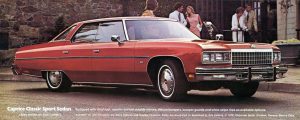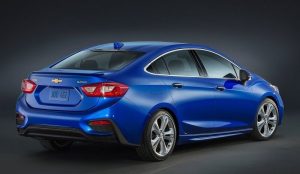Guest Post by Eric Peters

Cars are so much better than the government had intended that one can only imagine how good they might have been had the government not been involved at all.
In the first place, the government meant for most of us (but not them) to be driving small cars with not much power. This was the purpose of Corporate Average Fuel Economy requirements, which first went into effect back in the 1970s.
It is my sincere desire to provide readers of this site with the best unbiased information available, and a forum where it can be discussed openly, as our Founders intended. But it is not easy nor inexpensive to do so, especially when those who wish to prevent us from making the truth known, attack us without mercy on all fronts on a daily basis. So each time you visit the site, I would ask that you consider the value that you receive and have received from The Burning Platform and the community of which you are a vital part. I can't do it all alone, and I need your help and support to keep it alive. Please consider contributing an amount commensurate to the value that you receive from this site and community, or even by becoming a sustaining supporter through periodic contributions. [Burning Platform LLC - PO Box 1520 Kulpsville, PA 19443] or Paypal
-----------------------------------------------------
To donate via Stripe, click here.
-----------------------------------------------------
Use promo code ILMF2, and save up to 66% on all MyPillow purchases. (The Burning Platform benefits when you use this promo code.)
And initially, it worked exactly as intended.
Cars got “downsized” across the board. The typical layout of the American family car went from rear-wheel-drive with a V8 engine up front to front-wheel-drive with a four cylinder engine parked on top of the front wheels. Cars shed horsepower and engine displacement as well as curb weight, as the engineers groped for more MPGs. Instead of 4,000 pound Impalas with 5.7 liter 350s (and 7.4 liter 454s) under their hoods, Americans found themselves driving 2,800 lb. pound K cars with 2.6 liter “hemi” fours.
Then something marvelous happened.
As a side effect of the quest for Ever More Efficient, engine power began to swell again. Things like roller (rather than flat tappet) camshafts allowed more aggressive valve timing without costing gas or drivability. Cylinder heads – which were increasingly being made out of aluminum rather than cast iron – flowed more air, which made more power. Carburetors were replaced by electronic fuel injection.
All of these things – which are now standard equipment in economy cars – were once exotic technologies used in race cars or very expensive high-performance cars.
We began to have our cake – while Uncle had his, too.
The upswell in power – and performance – continues to this day. Current year family sedans are quicker than most muscle cars ever were – and twice as fuel-efficient.
It must be infuriating.
Prices, also, have remained reasonable – notwithstanding the constant piling-on of federal mandates that have added expense to cars.
Some will disagree with this – pointing out that the average price paid for a new car is now well over $30,000. This is perfectly true. But it is also perfectly true that there are lots of cars available for about half that and they’re not lacking amenities – or power.
A side-by-side comparison of what was available Then vs. Now – and for how much – is very revealing:
A 2017 Chevy Cruze sedan, as a for instance, stickers for $16,975 – which is almost exactly what a 1981 K-car cost brand-new, in inflation-adjusted dollars ($5,880 in 1981 – the base price of a new K-car – has the same buying power today as $16,477).
The Cruze comes standard with a turbocharged 1.4 liter engine that produces 153 hp and gets the car to 60 MPH in about 8.8 seconds; it comes standard with climate control AC, power windows and locks, a four speaker stereo with in-car WiFi hot spot and a seven inch LCD touchscreen.
The ’81 K-car had a 2.2 liter engine without a turbo that made 82 hp and got the car to 60 in about 12 seconds – without air conditioning or power locks or a stereo with Wi-Fi and a seven-inch LCD touchscreen.
It came with a three-speed automatic (the Cruze comes with a six-speed automatic) a speedometer and some idiot lights.
It did, however, get very good gas mileage: 29 city, 41 highway – which the new Cruze, with all its technological advantages, only manages to just roughly equal (30 city, 40 highway). But this is due to government meddling – specifically, government demands that new cars meet impact standards the K-car and its like could never have met – which have badly hurt the fuel-efficiency potential of modern cars.
The ’81 K-car only weighed 2,338 lbs. A 2017 Chevy Cruze weighs about 500 pounds more (2,870 lbs.) and this added bulk is mostly structural steel – added to make the car more able to absorb impact forces. Which is not a bad thing, except that it compromises the fuel economy potential of the car.
A Cruze that weighed what the K-car did – with all the efficiency advantages of 2017 – would almost certainly achieve at least 50 MPG on the highway.
But the point is that notwithstanding almost 40 years of piling-on regulations and mandates, a modern K-car equivalent like the Cruze is a vastly superior car by just about any measure. It is much more powerful and equipped with amenities that would have been inconceivable back in ’81.
Yet costs almost exactly the same in real terms.
This is nothing less than a miracle . . . of the market. A testimony in steel and glass and plastic to the seemingly inexhaustible ingenuity of the engineers. Who – despite the obstacles put in their way – have managed to give us cars that perform better and are much better-equipped for no more money than cars cost us decades ago.
Can you imagine what might be possible if they were free to design cars without government constantly interfering?





It is a loosing battle. Writing regulations is so much easier than engineering.
‘Loosing` battle? So was trying to teach you to spell, overthecliff…
Was there any incentive at all at changing the direction car companies were going in PRIOR to regulation?
Ralph Nader and safety issues may have been a big part of regulation nation. Once any Agency/ Dept. has a task, the object of the boss is to always make it more important by growing it larger. Boss becomes ‘more important’ with more employees and larger income.
There is never a desire to make the Agency/Dept smaller.
So the problem is not in the agencies’ original intentions and aims, nor in the possibly accidental fallout of compliance. The problem is in allowing agencies to outgrow their societal usefulness?
Look at EPA – did aq great job on water and air quality; they were 95% done and most of their future was maintaining.
But, they had to ‘find’ new scary things. Fear-mongering has always gotten money from the Gov’t; the more egregious the publicity, the bigger the windfall.
It is always about the money.
You must remember the only rule: The first priority of a bureaucracy is to maintain and grow the bureaucracy.
Most GovCo regulations are actually intended to increase cost and decrease productivity, purposefully. Technology advances are naturally deflationary, GovCo regulations are intentionally inflationary. Got to keep the gravy train rolling.
The lawyer/lawmakers command the impossible. Then they incarcerate the people who can’t change the laws of physics. So very soviet.
That ol’ nasty gov’mint is out to git us!
I must admit that it’s just as plausible that these improvements happened because of the government as in spite of the government. Neither assertion is falsifiable without running parallel universes. One thing I must take issue with: the preference for electric windows. With electric windows all it takes is a slide into one of our 10,000 lakes and you’re Mary Jo Kopechne.
In the late 80s early 90s Ford produced a model called the Probe. A local guy bought one that was a lemon and parked it outside the dealership and painted “I GOT PROBED AT SUN VALLEY FORD” on the hood, sides and trunk of the car. The dealership sought an injunction, was denied and eventually went out of business. Score 1 for the little guy.
Greetings,
I went to a city council meeting last Monday where the topic of discussion was parking and our city’s plan to add a new and hideous parking structure downtown where a small park currently stands.
I asked the council why this was necessary given that the millennials do not purchase or own vehicles. I asked them what studies the city has undertaken to measure the impact of driverless cars picking everyone up and given that the driverless cars will be owned by the car companies and that it wont even be possible for the average citizen to buy one (after all, Ford & GM doesn’t want YOUR driverless car competing with their driverless car) why it was necessary to add parking? I then went on to ask the city how it planned to fund itself once the cash cow of ticketing drivers goes away since the driverless cars can not do anything that would ever require a ticket. The city gets a full 1/2 of its operating expense paid for by harassing motorists.
These pathetic clowns looked at me as if I were some gibberish speaking space alien. Of course they need new parking because that is how they feed taxpayer money to their Union supporters. Once all the cost overruns come into play, there is money for all the crooks!
I suspect government at all levels is 100% unprepared for what is about to happen in transportation. Their excuse to harass motorists is about to come to an end and all the money that comes with it. I cant wait.
what amazes me is that people look at government officials as somehow “above” the average individual and this trust in government to provide is rampant among those of a populace when in fact any of these govt fools may have been a next door neighbor. how many out there would trust their next door neighbor with running a neighborhood carwash let alone a city…
given so few people are able to deal in fields of logic and to think “outside the box” or process information from several sources to lead to a conclusion (ie risk management, actuaries, economists…) why would one expect to be looked at with anything but confusion and lack of understanding. how many folks out there simply believe that food comes from a grocery store and is magically on the shelves? that if out of an item, a clerk should be able to simply go to the back and retrieve more…
NickelthroweR, you are 1000% correct. If you want to throw you money down the toilet, invest in new parking structures. Unless they are built with tall ceilings and thus can be retrofitted into an office building, they will be obsolete in only few years. Autonomous vehicles and the spread of Uber/Lyft means the need for most parking will disappear. The fact your City Councilors don’t see this is not surprising. These people were not elected due to their intelligence.
About the price of automobiles, you should factor in inflation when comparing 1960’s prices to today. Divide the price of a car today by 10 to get the approximate price from the 60’s. The same goes for a lot of things that we buy. Gasoline is about 10 times higher. Food was a pretty good bargain today till just lately when it has gone higher.
Remember what salaries were in the 60’s. Minimum wage was 85 cents an hour. Now it’s abbout ten times that. My dad was making $100 a week. Now he would be making $1000 for the same job. I was too young to work then.
College tuition, however, has inflated much more than the inflation rate. But many college degrees are worth far less than then.
Consider the quality of automobiles today. They are much better than any time in the past.
The question remains; would the cars be as good today if the government hadn’t stuck it’s nose into them? The answer is; Yes and No. But then what does it matter. It is what it is.
granted cars are “expensive”, but not really… and one doesnt truly grasp the wonders of the auto engineering until one tears one down and rebuilds one. Thank goodness for automation otherwise affordability would be out the window.
I have a samurai that I have torn apart and rebuilt piece by piece and bolt by bolt… if pricing out OEM replacement or even updraded parts of higher performance quality autos easily run into the thousands and this is without taking into consideration electrical wiring and components that come as standard options like power windows, doors, cab lighting and any other goodies one can throw into an auto… this may not amount to 15k, but this isnt considering paying union wages, shipping, mark up and so on…
in regards to engineering wonders… some designs were fantastic given the care that goes along with maintenance… my cavalier is over a decade old, 340k miles on the original engine and transmission and still passes smog lol … despite gov interference